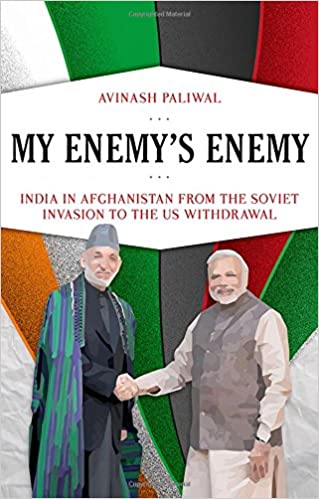In this book review, Vignesh Karthik KR (PhD Student, King’s College London) and Jeyannathann Karunanithi (Political Analyst, Chennai, India) reflect on Avinash Paliwal’s My Enemy’s Enemy during a time of significant change for Afghanistan.
Avinash Paliwal. My Enemy’s Enemy: India in Afghanistan from the Soviet Invasion to the US Withdrawal. Oxford University Press. 2017. 
On 29 February, 2020 a landmark agreement was signed between the United States of America and the Taliban that was designed to see the withdrawal of the majority of U.S. troops from Afghanistan. In a recent New York Times opinion piece written by Sirajuddin Haqqani, the deputy leader of the Taliban argued that “We [The Taliban] expect other countries to respect the sovereignty and stability of our country and consider it as a ground for cooperation rather than competition and conflict”.
As Haqqani’s statement implies, Afghanistan serves as an invaluable case study for those wanting to understand the place of Afghanistan within South Asia and the foreign policy maneuvers of weak states via global and regional powers within the country. And at this time of political change in Afghanistan, the influence of countries from South Asia in Afghanistan – especially that of India’s – is extremely pertinent. An excellent place to begin in understanding what Haqqani refers to when he calls for Afghanistan not to be “a ground for cooperation rather than competition and conflict” is with My Enemy’s Enemy: India in Afghanistan from the Soviet Invasion to the US Withdrawal (2017) written by Avinash Paliwal.
India’s presence in Afghanistan has been conspicuous right from King Zahir Shah’s reign (1933-1973), through to the Soviet Invasion (1979-1989), and its support for Ahmed Shah Massoud’s Northern Alliance against Taliban forces (1996-2001). Pakistan on the other hand (who Afghanistan shares a lukewarm relationship with due to unresolved differences over the Durrand line) clinched a breakthrough in the country with support to Afghan Mujahideen groups on behalf of the U.S. during the Soviet Invasion.
Pakistan’s role in the victory of the Taliban in 1996 cannot be overlooked. With 9/11 accelerating the U.S.’ action of dismantling the Taliban regime, India proceeded to maintain links with the Tajik-dominated Northern Alliance, while throwing its weight behind Hamid Karzai. These political maneuvers were matched with unfettered investments by India, aimed at creating infrastructure and additional capacity in the war-battered landscape. A few significant projects included a road from Delaram-Zaranj and another from Kandahar-Spin Boldak; and perhaps most significantly, the construction of the Afghan Parliament. Such Indian investments were in part made possible thanks to the relative stability provided by the U.S.’ presence in Afghanistan, which kept opposition forces in check.
In other words, India’s presence in Afghanistan achieved two objectives: firstly, it prevented the restoration of any form of a resurgent Taliban regime while seeking to limit Pakistan’s influence over any emergent regime in Afghanistan; and secondly, it developed long-term diplomatic ties and economic arrangements with a stable, popular and pro-Indian regime in Afghanistan (Ganguly and Howenstein 2009). With the recent signing of the agreement between the U.S. and Afghanistan, these two Indian foreign policy objectives in Afghanistan have potentially been jeopardised.
Paliwal’s application of the Advocacy Coalition Framework (ACF) to understand the political landscape of Afghanistan serves as an effective tool to unravel the proxy groups in Afghanistan that negotiate with global and regional powers. The need for such a framework to interpret the complexity of the political situation in Afghanistan is necessitated by the dynamic nature of the political landscape across time and space. Edward T. Hall’s dance metaphor of ‘the perpetual ballet’ serves in Paliwals’ analysis as a useful concept to denote the complex culturo-geo-political situation in Afghanistan, dating back from the ‘Great Game’.
Paliwal argues that the foreign policy behaviour of weak states is not simply decided by external systemic and regional factors, but rather is influenced by domestic factors – most notably in this case the influence of domestic Afghan policy that realigns, evolves and responds to both India and Pakistan’s policies towards Afghanistan, thus balancing both factional and national policy interests.
One of Paliwal’s central arguments is that while most Afghans would like good relations with India, a section of Afghans have preferred closer relations with Pakistan, thereby influencing Kabul’s approach towards New Delhi. In the wake of the Taliban’s emergence, the latter stand to gain more influence.
This book explains the trajectory of the relationship between India and Afghanistan by dividing their history into three phases: Debating Neutrality, Debating Containment and Debating Engagement. In the present context, with the possible emergence of sections of the Taliban as legitimate decision-makers in Afghanistan, revisiting the Debating Containment phase is extremely useful. As explained in the book, the Indian foreign policy establishment can be divided into two groups: Conciliators and Partisans.
Paliwal uses his conceptual framework (based on the application of the ACF) to analyse the negotiations that took place when the Indian Airlines flight 814 was hijacked in 1999. His analysis reveals the sub-optimal outcome in the ‘possibility space’ in the negotiations, due to the anti-engagement attitude of the foreign policy establishment in 1999, which then saw the dominance of Partisans.
Partisans toed the line that political factions at odds with Pakistan were allies, while those not aligned with India’s position needed to be contained. This situation when juxtaposed with the Conciliators’ strategy of Debating Neutrality, when Indian intelligence agencies were in touch with those in power as well as the opposition, revealed the critical need for maintaining meaningful contact with all stakeholders.
While Paliwal focused on the revival of the strategy of Conciliators to voice public opposition to the Taliban (while at the same time maintaining discreet engagement with other faction) the present situation in 2020 merits the need for a strategy that rests on realpolitik to engage with various factions within the Taliban.
It is of concern to India that Indian assets in Afghanistan were targeted by the Haqqani group, a major Taliban faction. At the same time, it is worth mentioning that Taliban cannot be characterised merely as a jihadi proxy created by Inter-Services Intelligence (ISI). Instead, one can argue that the formation of the Taliban is a coming together of various factions with different interests, and varying degrees of allegiance, at times non-allegiance, to political and military leadership of Pakistan.
In the 2010s, the Indian foreign policy establishment embraced a much more nuanced approach towards the Taliban. The Conciliators’ strategy is now put to the test with the increasing political instability in Afghanistan, despite the power-sharing agreement signed on May 17, 2020 between Afghan President Ashraf Ghani and former Chief Executive Abdullah Abdullah. It is to be noted that Abdullah Abdullah was associated with the Northern Alliance during the war with the Taliban from 1996-2001.
In the present climate, the uneasy balance between Ghani and Abdullah should be of real concern to the democratic future of the country, given the conduct of parallel presidential swearing-in ceremonies in Kabul on March 9, 2020, even though Ghani was declared the winner of the 2019 presidential election by the country’s Independent Election Commission. Abdullah raised doubts regarding the legitimacy of the mandate.
In the wake of the apparent legitimacy and sway secured by the Taliban through the internal affairs of Afghanistan due to the agreement, in the near future, the trajectory of India’s foreign policy towards Afghanistan is likely to be revised. In fact, as Afghanistan’s political future continues to be written, books like Paliwal’s serve as an extremely useful resource in understanding the historic – as well as many contemporary – regional pressures exerted on the country.
Listen to Friends, Enemies or just Neighbours? The Afghanistan, Pakistan and India Triangle, recorded on 5 June, 2019. The recording includes a contribution from author Avinash Paliwal.
This article gives the views of the authors, and not the position of the South Asia @ LSE blog, nor of the London School of Economics. Featured photo: Damien Surgeon, Flickr, Creative Commons, 2.0 Generic (CC BY 2.0).








Good review of book.